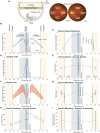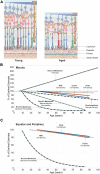Variability in Retinal Neuron Populations and Associated Variations in Mass Transport Systems of the Retina in Health and Aging
- PMID: 35283756
- PMCID: PMC8914054
- DOI: 10.3389/fnagi.2022.778404
Variability in Retinal Neuron Populations and Associated Variations in Mass Transport Systems of the Retina in Health and Aging
Abstract
Aging is associated with a broad range of visual impairments that can have dramatic consequences on the quality of life of those impacted. These changes are driven by a complex series of alterations affecting interactions between multiple cellular and extracellular elements. The resilience of many of these interactions may be key to minimal loss of visual function in aging; yet many of them remain poorly understood. In this review, we focus on the relation between retinal neurons and their respective mass transport systems. These metabolite delivery systems include the retinal vasculature, which lies within the inner portion of the retina, and the choroidal vasculature located externally to the retinal tissue. A framework for investigation is proposed and applied to identify the structures and processes determining retinal mass transport at the cellular and tissue levels. Spatial variability in the structure of the retina and changes observed in aging are then harnessed to explore the relation between variations in neuron populations and those seen among retinal metabolite delivery systems. Existing data demonstrate that the relation between inner retinal neurons and their mass transport systems is different in nature from that observed between the outer retina and choroid. The most prominent structural changes observed across the eye and in aging are seen in Bruch's membrane, which forms a selective barrier to mass transfers at the interface between the choroidal vasculature and the outer retina.
Keywords: Bruch’s membrane; aging; choriocapillaris; mass transport; photoreceptors; retina; retinal neurons; retinal vasculature.
Copyright © 2022 Zouache.
Conflict of interest statement
The author declares that the research was conducted in the absence of any commercial or financial relationships that could be construed as a potential conflict of interest.
Figures





Similar articles
-
Retinal Distribution and Extracellular Activity of Granzyme B: A Serine Protease That Degrades Retinal Pigment Epithelial Tight Junctions and Extracellular Matrix Proteins.Front Immunol. 2020 Apr 7;11:574. doi: 10.3389/fimmu.2020.00574. eCollection 2020. Front Immunol. 2020. PMID: 32318066 Free PMC article.
-
Oxygen distribution and consumption within the retina in vascularised and avascular retinas and in animal models of retinal disease.Prog Retin Eye Res. 2001 Mar;20(2):175-208. doi: 10.1016/s1350-9462(00)00027-6. Prog Retin Eye Res. 2001. PMID: 11173251 Review.
-
Interactions of the choroid, Bruch's membrane, retinal pigment epithelium, and neurosensory retina collaborate to form the outer blood-retinal-barrier.Prog Retin Eye Res. 2020 May;76:100803. doi: 10.1016/j.preteyeres.2019.100803. Epub 2019 Nov 5. Prog Retin Eye Res. 2020. PMID: 31704339 Review.
-
Histologic and morphometric analysis of the choroid, Bruch's membrane, and retinal pigment epithelium in postmortem eyes with age-related macular degeneration and histologic examination of surgically excised choroidal neovascular membranes.Surv Ophthalmol. 1999 Oct;44 Suppl 1:S10-32. doi: 10.1016/s0039-6257(99)00086-7. Surv Ophthalmol. 1999. PMID: 10548114
-
Peripapillary chorioretinal atrophy: Bruch's membrane changes and photoreceptor loss.Ophthalmology. 2000 Feb;107(2):334-43. doi: 10.1016/s0161-6420(99)00037-8. Ophthalmology. 2000. PMID: 10690836
Cited by
-
Age-Related Macular Degeneration, a Mathematically Tractable Disease.Invest Ophthalmol Vis Sci. 2024 Mar 5;65(3):4. doi: 10.1167/iovs.65.3.4. Invest Ophthalmol Vis Sci. 2024. PMID: 38466281 Free PMC article. Review.
-
Levels of complement factor H-related 4 protein do not influence susceptibility to age-related macular degeneration or its course of progression.Nat Commun. 2024 Jan 10;15(1):443. doi: 10.1038/s41467-023-44605-0. Nat Commun. 2024. PMID: 38200010 Free PMC article.
-
Linking Vascular Structure and Function: Image-Based Virtual Populations of the Retina.Invest Ophthalmol Vis Sci. 2024 Apr 1;65(4):40. doi: 10.1167/iovs.65.4.40. Invest Ophthalmol Vis Sci. 2024. PMID: 38683566 Free PMC article.
-
"Energetics of the outer retina I: Estimates of nutrient exchange and ATP generation".PLoS One. 2024 Dec 31;19(12):e0312260. doi: 10.1371/journal.pone.0312260. eCollection 2024. PLoS One. 2024. PMID: 39739933 Free PMC article.
-
Modeling complex age-related eye disease.Prog Retin Eye Res. 2024 May;100:101247. doi: 10.1016/j.preteyeres.2024.101247. Epub 2024 Feb 15. Prog Retin Eye Res. 2024. PMID: 38365085 Free PMC article. Review.
References
-
- Alberts B., Johnson A., Lewis J., Raff M., Roberts K., Walter P. (2014). Molecular biology of the cell, 6th Edn. New York, NY: Garland Science, 10.1201/9780203833445 - DOI
Publication types
LinkOut - more resources
Full Text Sources

